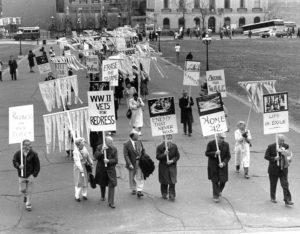Gallery Scene/Seen
Four exhibitions at the Carleton art gallery
Maureen Korp
What do you know of anyone from appearance alone? Is that person a friend? Or enemy? Even a saint? Whatever the answer, what happens then? What stories will be told?
Four new exhibitions at the Carleton University Art Gallery address these questions.
Two are solo exhibitions located on the lower floor: “SuperNova” by video artist Rah Eleh; and, “Saints and Madonnas,” the work of photographer Olivia Johnston. Both exhibitions are curated by Heather Anderson.
“SuperNova” by Rah is a short video. Viewers see it by sitting in a structure built for this purpose. Now you are one of the judges in the artist’s brutal parody of television talent shows. “SuperNova” performances take place in multiple dimensions. Of three contestants, Fatimah’s heartwrenching recitation in an ancient Persian language is the clear winner. Its beauty needs no translation. That is its meaning.
“Saints and Madonnas”— Who is a saint? How would you know? Is there a telltale glow?

Photographer Olivia Johnston has long studied the traditions and tales of sainthood in the Catholic Church. “Saints and Madonnas,” features the artist’s own photography as well as the work of others from the gallery’s permanent collection, among them: Carl Beam, Salvador Dali, Jennifer Dickson, and Charles Sheeler.
On one wall are two large inkjet prints by Johnston, each the portrait of a young man, unclothed and unadorned (except for small tattoos). One is entitled “St. Francis (Frans),” the other “St. Stephen (Stephane).” The men are posed like icons. Is each, therefore, a saint? Not sure? Look for the attribute—an object, placed nearby, and used to identify or name a particular saint. Another portrait entitled “St. Peter (Ben),” for example, hangs beside a small etching by Tony Urquhart of a box of keys. In Catholic iconography, St. Peter’s attribute is the key, because “Peter holds the keys to the Kingdom of Heaven.”
Memories of Japanese Canadian internments
Two historically interrelated exhibitions are located on the gallery’s upper floor: “Inheriting Redress” and “Sites of Memory.” Both exhibitions interrogate what is remembered and said today of Canada’s WWII internments of 22,000 “enemy aliens.” Nearly all were, in fact, Canadians of Japanese origin or heritage.

The centrepiece of “Inheriting Redress” is a short film by Michael Fukushima, “Minoru: Memory of Exile.” Using archival materials, Fukushima tells his family’s tale—citizenship denied; property confiscated and sold; then, at the end of the war, the family was deported to Japan. A year later, 1947, the government of Canada cancelled its deportation orders and permitted deportees to return to Canada. Many did. Fukushima says of his father, “I am a Canadian because he struggled to be a Canadian.”
The exhibition, curated by Emily Putnam and Rebecca Dolgoy, is sourced from materials they located in the Ottawa Japanese Community Association Archive, and the gallery’s own collection.
“Sites of Memory: Legacies of the Japanese-Canadian Internment,” displays the work of three contemporary Canadian artists of Japanese heritage: Norman Takeuchi, Emma Nishimura, and Cindy Mochizuki. All three artists question what happened, and what is remembered of the internment period. The exhibition is curated by Emily Putnam.

An installation by Norman Takeuchi, entitled “A Measured Act,” displays five paper kimonos, each one named after one of the five camps to which people were hauled. From a distance, the five appear to be beautiful kimonos. Closer, each is a collage made of the archival materials of those times, their designs based on stories Takeuchi heard. Shelves nearby display the artist’s drawings of items people grabbed at the last minute to take with them—teapot, child’s baseball glove, bottle of soya sauce.
Emma Nishimura continues to ask people to tell her their stories. These are the materials she is using in two ongoing series: “Collected Stories,” etchings; and, “An Archive of Rememory,” eighty wrapped furoshiki bundles. In Japan, parcels of varying sizes are skillfully bundled into furoshiki for easy carrying. Furoshiki are usually squares of beautiful fabric. Their use is intended to honour what is being carried and to whom it will be given.
To survive those times people kept their thoughts to themselves. Taught their children to walk straight and talk nicely. We see this sense of propriety in Cindy Mochizuki’s short film, “Sue Sada was Here.” Ten female dancers, aged 8-85, walk, sit, stand beautifully. They carry perfectly balanced books on their heads. The film’s text is taken from the writings of Muriel Kitagawa (1912-1974), of Vancouver whose pennames included “Sue Sada.” She, too, was one of the 22,000.
After the war did people speak of these betrayals? No. “Shigata ganai” (“It happened. No need to discuss it.”) was the usual response if a child asked, “What happened? Why?”
It would be nearly 50 years before stories were collected and told by the children of those who had been denied their humanity and personhood.
What have all four exhibitions in common? Each is a study of visual sign, symbol, and personhood.
The curators have made good use of these levels. There is a respectful separation of the artists’ work, and, at the same time, the possibility of relationship and complementarity among the four exhibitions.
Saints and Madonnas, SuperNova continuing until 8 December
Inheriting Redress, Sites of Memory continuing until 26 January 2020
Carleton University Art Gallery
St. Patrick’s Building
1125 Colonel By Drive. Free.
Gallery hours: Tues. to Fri.,
10.00—17.00; Sat. and Sun., 12.00—17.00
Other exhibitions of interest in Ottawa
Doris Lamontagne: Ici / Ailleurs, continuing until 22 October
Voix Visuelle, 67 Beechwood Ave.
